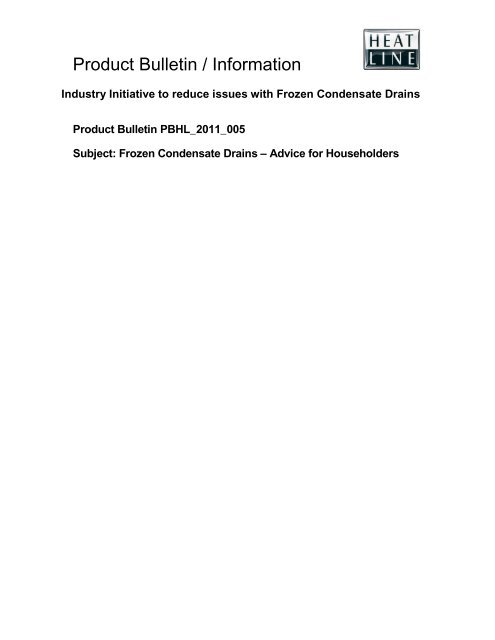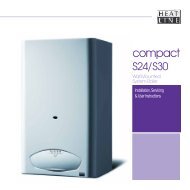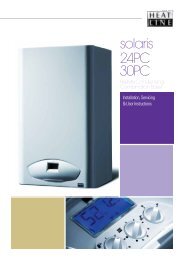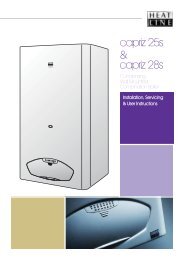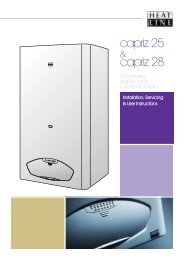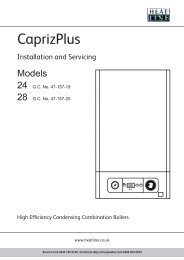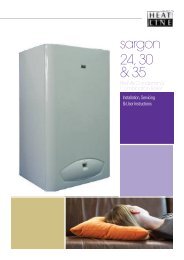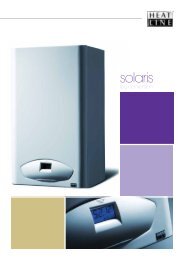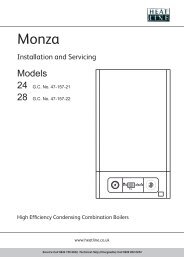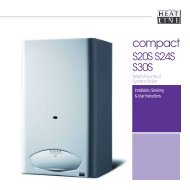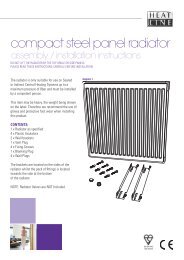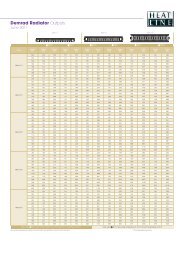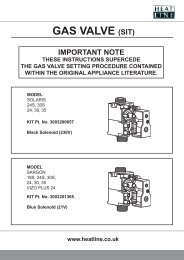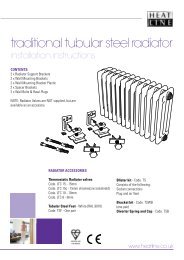Frozen Condensate Drains - Advice to Householders - Heatline
Frozen Condensate Drains - Advice to Householders - Heatline
Frozen Condensate Drains - Advice to Householders - Heatline
Create successful ePaper yourself
Turn your PDF publications into a flip-book with our unique Google optimized e-Paper software.
Product Bulletin / Information<br />
Industry Initiative <strong>to</strong> reduce issues with <strong>Frozen</strong> <strong>Condensate</strong> <strong>Drains</strong><br />
Product Bulletin PBHL_2011_005<br />
Subject: <strong>Frozen</strong> <strong>Condensate</strong> <strong>Drains</strong> – <strong>Advice</strong> for <strong>Householders</strong>
Product Bulletin / Information<br />
Industry Initiative <strong>to</strong> reduce issues with <strong>Frozen</strong> <strong>Condensate</strong> <strong>Drains</strong>
Product Bulletin / Information<br />
Industry Initiative <strong>to</strong> reduce issues with <strong>Frozen</strong> <strong>Condensate</strong> <strong>Drains</strong><br />
During recent winters the UK has experienced prolonged spells of extremely cold weather<br />
- down <strong>to</strong> minus 20oC and below in many areas. This resulted in a significant increase in<br />
the number of calls <strong>to</strong> boiler manufacturers and heating engineers from householders with<br />
condensing (high efficiency) boilers where the condensate drainage pipe had frozen and<br />
become blocked with ice, causing the boiler <strong>to</strong> shut down. In the vast majority of cases<br />
such problems occur where the condensate drainage pipe is located externally <strong>to</strong> the<br />
building for some part of its length.<br />
British Standards, Building Regulations and boiler manufacturers’ installation instructions<br />
currently allow condensate drainage pipes <strong>to</strong> be located either internally or externally, or a<br />
combination of these. These documents give guidance on how <strong>to</strong> install the condensate<br />
drainage pipes in order <strong>to</strong> reduce the possibility of freezing. However this guidance may<br />
not be sufficient <strong>to</strong> prevent freezing in extreme conditions of the type recently experienced<br />
in the UK - with widespread and prolonged very low temperatures.<br />
There are a number of measures, detailed below, which householders can take in order <strong>to</strong><br />
thaw a frozen condensate drainage pipe, free the blockage and re-start the boiler<br />
themselves provided they feel competent <strong>to</strong> do so (see Note 1) –<br />
1. Confirm that a frozen condensate drain pipe is the cause of shutdown.<br />
It is important <strong>to</strong> confirm that a frozen condensate drainage pipe is the likely cause of the<br />
problem before taking any of the remedial actions suggested below. The condensate<br />
drainage pipe is a plastic pipe (typically grey or white in colour) connected <strong>to</strong> the bot<strong>to</strong>m of<br />
your boiler.<br />
If the following circumstances apply then it is probable that a frozen condensate drainage<br />
pipe is the cause -
Product Bulletin / Information<br />
Industry Initiative <strong>to</strong> reduce issues with <strong>Frozen</strong> <strong>Condensate</strong> <strong>Drains</strong><br />
outside temperatures have been below freezing for some time.<br />
the condensate drainage pipe runs through the wall and outside the property for<br />
part of its length, without any increased pipe diameter, any insulation on it, or other<br />
measures <strong>to</strong> prevent freezing. There may also be a problem if the pipe runs<br />
through an enclosed but unheated area, such as a garage or loft.<br />
the boiler has previously been working satisfac<strong>to</strong>rily.<br />
Shutdown due <strong>to</strong> freezing and blockage of the condensate drainage pipe will usually be<br />
indicated by a “fault code” on the boiler’s digital display, although this may not specifically<br />
indicate freezing as the fault. Indication may also be given by some other alarm such as a<br />
flashing light, or by a symp<strong>to</strong>m such as “gurgling” noises coming from the boiler.<br />
Note 2 - please refer <strong>to</strong> the boiler manual for guidance on fault codes/alarms and their<br />
meaning - the boiler manufacturer or the servicing company you use may also have a<br />
helpline or website giving guidance on this.<br />
2. Locate the blockage.<br />
It is likely that the pipe is frozen at the most exposed point external <strong>to</strong> the building or<br />
where there is some obstruction <strong>to</strong> flow. This could be at the open end of the pipe, at a<br />
bend or elbow, or where there is a dip in the pipe in which condensate can collect. The<br />
location of the blockage should be identified as closely as possible before taking further<br />
action.<br />
3. Thaw the frozen pipe.<br />
The pipe can be thawed by applying a hot water bottle, a microwaveable heating pack<br />
(the sort used for muscular aches and pains) or cloths soaked in warm water <strong>to</strong> the<br />
exterior of the pipe, close <strong>to</strong> the likely point of blockage. Warm water can also be poured<br />
on<strong>to</strong> the pipe from a watering can or similar container. Do not use boiling water.<br />
Note 3: You should not attempt <strong>to</strong> thaw a condensate drain pipe if you cannot easily reach<br />
it from ground level. Be aware that any water used can quickly freeze if it falls on<strong>to</strong><br />
pathways - causing a possible slip hazard.<br />
4. Reset/re-start the boiler.<br />
Once the blockage has been thawed and cleared, consult the boiler operating instructions<br />
or check the manufacturer’s website for guidance on any action needed <strong>to</strong> “reset” the fault<br />
code/alarm and re-start the boiler.<br />
In most cases, once the condensate drain pipe is cleared and a reset has been carried<br />
out, the boiler will re-ignite using an au<strong>to</strong>matic operating sequence.<br />
If this reset/restart does not succeed you should call in a competent engineer <strong>to</strong> assess<br />
the situation and take further action if required. Registered gas engineers in your area can<br />
be found using the postcode search facility on the Gas Safe Register website at<br />
www.gassaferegister.co.uk
Product Bulletin / Information<br />
Industry Initiative <strong>to</strong> reduce issues with <strong>Frozen</strong> <strong>Condensate</strong> <strong>Drains</strong><br />
5. Temporary remedial actions:<br />
If the pipe is successfully thawed and the boiler can be re-started then the following<br />
temporary remedial actions may help prevent re-freezing if the severe weather continues.<br />
a) If the external pipe is not insulated as recommended, you should try <strong>to</strong> rectify this by<br />
attaching suitable water-proof and weather-proof insulation over the outside of the pipe <strong>to</strong><br />
prevent re-freezing. “Class O” pipe insulation is suitable for external use and should be<br />
available from DIY outlets and plumbing/heating suppliers.<br />
b) During the cold spell it may help <strong>to</strong> temporarily run the heating system with the boiler<br />
thermostat (as distinct from the room thermostat) set <strong>to</strong> maximum. Turn back <strong>to</strong> the<br />
normal setting used once the cold spell is over.<br />
c) It may also help <strong>to</strong> temporarily set the central heating timer/programmer <strong>to</strong><br />
“continuous” (24hr) mode, setting the room thermostat overnight <strong>to</strong> around 15oC. Again,<br />
return <strong>to</strong> the normal settings once the cold spell is over.<br />
6. Longer term actions:<br />
As previously stated, British Standards, Building Regulations etc. currently allow<br />
condensate drainage pipes <strong>to</strong> run either internally or externally, or a combination of these.<br />
These documents give recommendations on how <strong>to</strong> run the pipe and use insulation, if<br />
required, in order <strong>to</strong> reduce the possibility of freezing, This guidance was based on<br />
prevailing UK winter conditions, however it may not be sufficient <strong>to</strong> prevent freezing in<br />
extreme conditions of the type experienced over recent years.<br />
Should you wish <strong>to</strong> take action in order <strong>to</strong> reduce the risk of freezing in future, either by<br />
relocating the condensate drainage pipe or by taking other measures, then more detailed<br />
guidance is available from your heating installer, service engineer, or on-line here<br />
7. FAQs<br />
What is condensate and what does the condensate drain do?<br />
High efficiency (condensing) boilers remove more heat from the combustion gases,<br />
resulting in additional water vapour which is collected within the boiler as condensate, and<br />
taken <strong>to</strong> a suitable drain via the condensate drainage pipe.<br />
Why has my condensate drain only frozen recently?<br />
Recently the UK has suffered from unusually cold weather, over prolonged periods.<br />
Existing recommendations for condensate pipe installation, such as pipe insulation, were<br />
based on prevailing UK weather conditions and may not be sufficient in the extreme<br />
conditions recently experienced across much of the UK.
Product Bulletin / Information<br />
Industry Initiative <strong>to</strong> reduce issues with <strong>Frozen</strong> <strong>Condensate</strong> <strong>Drains</strong><br />
Shouldn’t my condensate drainage pipe have been installed correctly in the first<br />
place?<br />
British Standards, Building Regulations etc. currently allow condensate drainage pipes <strong>to</strong> be run<br />
internally, externally or a combination of these. These documents give recommendations on how <strong>to</strong><br />
run the pipe and use insulation in order <strong>to</strong> reduce the possibility of freezing. This guidance was<br />
based on the UK winter conditions prevailing until very recently, however it may not have<br />
been sufficient <strong>to</strong> prevent freezing in extreme weather conditions.<br />
Can I improve the pipe installation <strong>to</strong> prevent freezing?<br />
It would be advisable <strong>to</strong> examine the condensate drainage pipework and upgrade the<br />
installation if required, in order <strong>to</strong> reduce the risk of freezing in future. This should be done<br />
by a competent person and in accordance with relevant British Standards and industry<br />
guidance (see below).<br />
HHIC has published updated industry guidance on condensate drainage pipe installation,<br />
which should be followed if this work is carried out. Click here for full details<br />
A heating engineer cut the condensate pipe <strong>to</strong> get my boiler working and left the<br />
pipe discharging <strong>to</strong> a bucket as an “emergency measure”. Is this acceptable?<br />
It is recognised that in some instances (e.g. where an elderly person’s heating needs <strong>to</strong><br />
be reinstated as an emergency measure) frozen condensate drainage pipes may have<br />
been cut in order <strong>to</strong> bypass the blockage. This has been done <strong>to</strong> allow re-ignition of the<br />
boiler, with condensate being collected in a suitable container as a temporary solution.<br />
While not unsafe, this is not recommended practice and if such action has been taken then the<br />
condensate drainage pipe must be reinstated as soon as possible, using the appropriate industry<br />
guidance (see above) <strong>to</strong> reduce risk of freezing in future.


